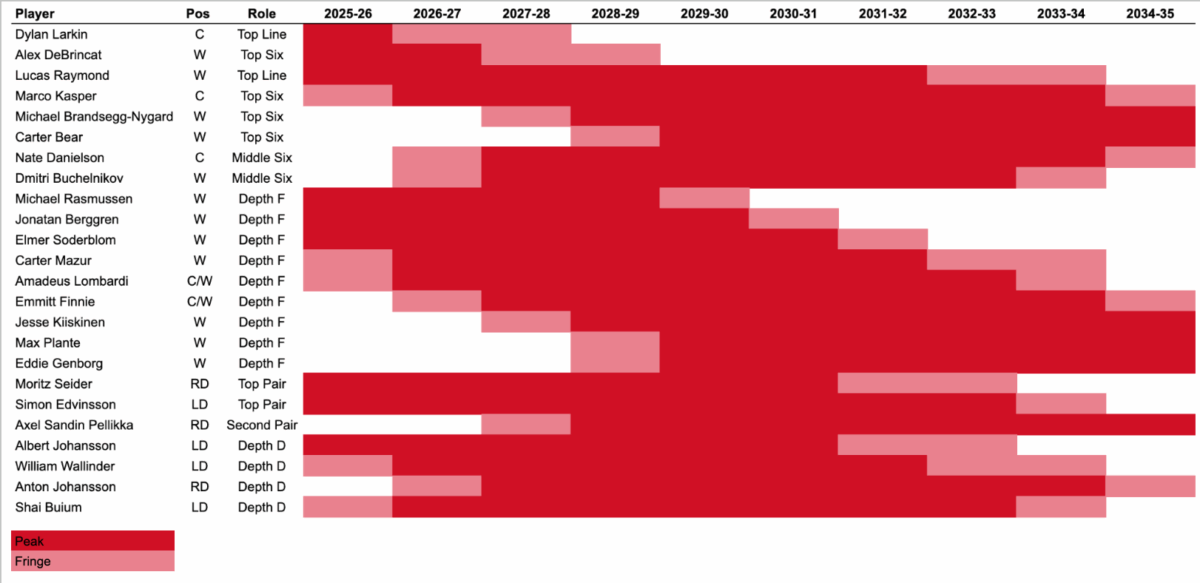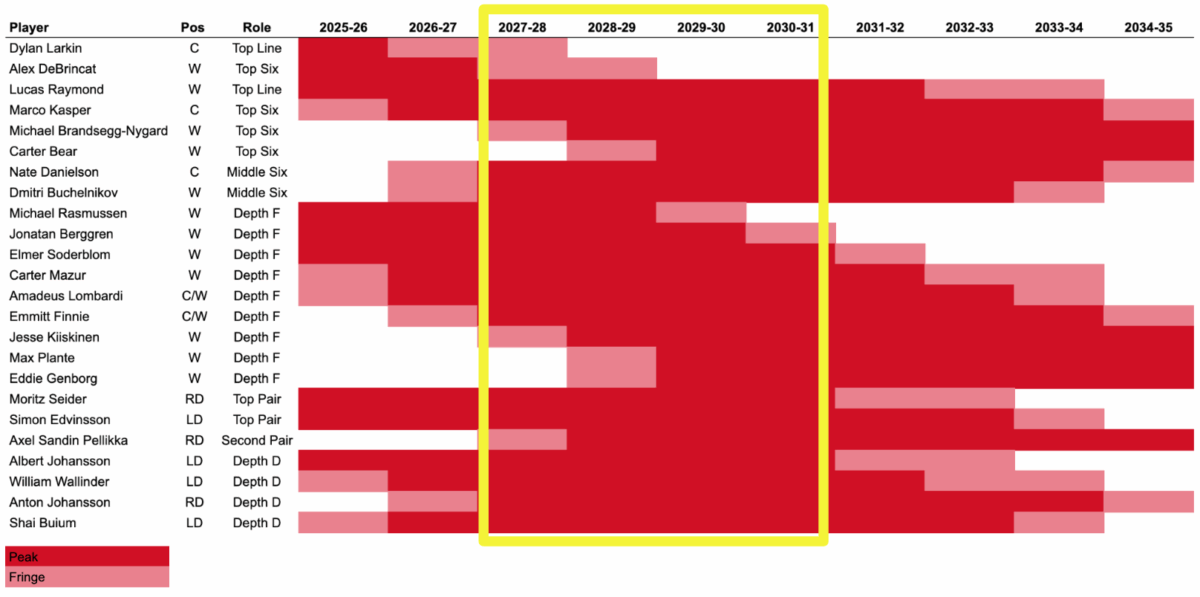Inevitably, the Detroit Red Wings’ rebuild comes up at every major NHL checkpoint. The trade deadline. The draft. Free agency. Death, taxes, and “what are the Red Wings even doing?”
A detailed analysis of Detroit’s rebuild, its strategy, and its results so far can be found here. But I’m not here to debate how Steve Yzerman and the front office have conducted the rebuild thus far. I’m here to determine when the organization will reach the light at the end of the tunnel.
When exactly will the Red Wings return to contention? What will that team look like and which puzzle pieces are still needed? My analysis below attempts to answer those questions.
Methodology
Before getting into the results, I want to share how I conducted this thought experiment. Essentially, I based my research on NHL age curves. There has been extensive work done on this topic, and I opted to leverage the analysis recently shared by Dom Luszczyszyn of The Athletic that features his Net Rating calculations (from ‘As NHL free agency nears, how will players age on their new contracts?’ – The Athletic – 6/5/2025). You can view the data here (paywall).
According to the calculations, a player’s peak or prime is roughly age 23 to 29 for forwards and 23 to 30 for defensemen. Note that this is my interpretation of age curves. To me, the timeframe when the age curve slope flattens out—not the apex—represents the player’s prime since the year-over-year change isn’t too great.
With these ranges, I mapped out Detroit’s core young players on a timeline. Essentially, this covers key players 29 and younger. Andrew Copp, Patrick Kane, J.T. Compher, and others who are not core players of the future were excluded.
The timeline shows when each player will be in their prime respective to their expected or current roles. It also indicates when they’re on the fringe and could be serviceable in a slightly lower role than what they would be in their peak.
The thought here is to identify when the Red Wings have the most players in their prime over the next 10 years. This would show when the organization would be their strongest, plus gaps in the lineup that should be addressed before then.
Red Wings’ Trajectory Through 2035
Here is how Detroit’s core players map out over the next 10 years:

Key Takeaways
- We’re not there yet, but the end of Dylan Larkin and Alex DeBrincat’s respective prime years isn’t that far off.
- It’s entirely possible that some of Marco Kasper, Nate Danielson, Michael Brandsegg-Nygard, and/or Carter Bear develop into true first-line forwards; this is more of a conservative lens to avoid overslotting.
- Defense looks very good with Moritz Seider, Simon Edvinsson, and Axel Sandin Pellikka leading the way.
- There’s plenty of depth at forward and defense to fill out the bottom six and bottom pair slots.
- Goalies were left off intentionally; Sebastian Cossa and Trey Augustine provide lots of promise in net, though.
Related: 3 Red Wings Prospects Entering Critical 2025-26 Season
Red Wings’ Next Contention Window
Now that we’ve mapped out Detroit’s future, we can hone in on when the organization will be at its best.

I estimate that the Red Wings’ next contention window will start in 2028. That’s when they’ll have the most players in their prime and sufficient depth.
During this time, they’ll have a top six that consists of Kasper, Brandsegg-Nygard, and Lucas Raymond, plus other players who could potentially contribute high in the lineup, including Larkin, Danielson, and Dmitri Buchelnikov. It’s possible DeBrincat is still around and producing at a middle-six pace as well. Bear, too, if he moves through the ranks quickly.
The blue line is especially promising, with Seider, Edvinsson, and Sandin Pellikka fully in their prime. Cossa and Augustine should be quality NHLers at this point, too.
Detroit’s lineup could look something like this:
| LW | C | RW |
| Michael Brandsegg-Nygard (21) | Dylan Larkin (31) | Lucas Raymond (25) |
| Dmitri Buchelnikov (24) | Marco Kasper (23) | Alex DeBrincat (29) |
| Elmer Soderblom (26) | Nate Danielson (22) | Carter Mazur (25) |
| Amadeus Lombardi (24) | Michael Rasmussen (28) | Jonatan Berggren (27) |
| Emmitt Finnie (22) | J.T. Compher (32) |
| LD | RD | G |
| Simon Edvinsson (24) | Moritz Seider (26) | Sebastian Cossa (24) |
| William Wallinder (25) | Axel Sandin Pellikka (22) | Trey Augustine (22) |
| Albert Johansson (27) | Anton Johansson (23) | |
| Shai Buium (24) |
Obviously, a lot will take place between now and the eve of the 2027-28 season. Detroit will have ample time to address gaps in the lineup and ensure they roster the best team possible.
Among the missing pieces are a top-line forward (or two) and a top-four defenseman. They’ll have a few offseasons, trade deadlines, and drafts to resolve these needs.
It’s also possible that the solutions come from within. Like I said above, players can exceed expectations in their development and elevate out of their projected roles. That’s how you ascend out of a rebuild. The Florida Panthers are a prime example of this – Carter Verhaeghe, Gustav Forsling, Niko Mikkola, and Eetu Luostarinen were not projected to be top-six forwards or top-four defensemen, but developed into those roles nonetheless.
Remember, Dylan Larkin’s scouting reports heading into the 2014 drafts projected him to top out as a solid, two-way second-line center. He developed into a bonafide 1C.
Related: Exploring the Red Wings’ 2025 Offseason Additions & Rumored Near Misses
Similarly, top-six forward or top-four defense roles can be filled effectively by players whose individual skills don’t jump off the page, but fit in well alongside more talented teammates. Bryan Rust is the poster boy for this. There’s also Kasperi Kapanen, Corey Perry, and Evan Rodrigues who played well in top-six roles in the 2025 Stanley Cup Final.
So while the future Red Wings have some gaps, they’re positioned well to address them.
Final Word
Based on my estimation, the Red Wings should become threats to go on deep playoff runs by the 2027-28 season. And over the next few years, they will have plenty of opportunities to add missing pieces, develop their prospects and young players, and take part in valuable learning experiences on the ice.
The rebuild is not done. But the team is ascending.
